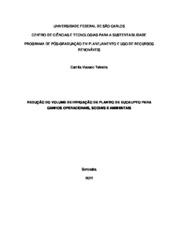| dc.contributor.author | Teixeira, Camila Macedo | |
| dc.date.accessioned | 2023-04-14T20:22:05Z | |
| dc.date.available | 2023-04-14T20:22:05Z | |
| dc.date.issued | 2023-03-07 | |
| dc.identifier.citation | TEIXEIRA, Camila Macedo. Redução do volume de irrigação de plantio de eucalipto para ganhos operacionais, sociais e ambientais. 2023. Dissertação (Mestrado em Planejamento e Uso de Recursos Renováveis) – Universidade Federal de São Carlos, Sorocaba, 2023. Disponível em: https://repositorio.ufscar.br/handle/ufscar/17749. | * |
| dc.identifier.uri | https://repositorio.ufscar.br/handle/ufscar/17749 | |
| dc.description.abstract | The forestry Market has expanded throughout the world significantly in recente years. Because of this growth, the challenges of increasing productivity and competitiveness among companies for forestry training based on sustainable ESG (Enviroental, Social and Governance) concepts growth as well. Therefore, this Project aims to assess the potential for reducing the volume of irrigation water from Eucalyptus forestry activities. The Project analyzed the operations of irrigated planting and conventional planting (planting and irrigation independent) and was divided into five main treatments: T0 (no irrigation), T1 (an irrigation of 250 ml/plant), T2 (an irrigation of 4 l/ plant), T3 (two irrigations, the first being 250 ml/plant) and T4 (two irrigations of 4 l/plant). The experiments were executed in São Paulo state between may to december and genetical material does not present any resistance to water deficit. The initial results measured the mortality rate of the different treatments and presented no significant results between T3 and T4 from may to june and significant results between T3 and T4 from july to august. There is a potential to reduce the volume of water during planting to 250 ml/plant in the first irrigation during humid period of the year. As a result, opportunities to reduce the volume of irrigation water were identified, with significant gains in the use of renewable resources and in line with ESG guidelines. | eng |
| dc.description.sponsorship | Não recebi financiamento | por |
| dc.language.iso | por | por |
| dc.publisher | Universidade Federal de São Carlos | por |
| dc.rights | Attribution-NonCommercial-NoDerivs 3.0 Brazil | * |
| dc.rights.uri | http://creativecommons.org/licenses/by-nc-nd/3.0/br/ | * |
| dc.subject | ESG | por |
| dc.subject | Silvicultura | por |
| dc.subject | Volume de Água | por |
| dc.subject | Silviculture | eng |
| dc.subject | Water Volumn | eng |
| dc.title | Redução do volume de irrigação de plantio de eucalipto para ganhos operacionais, sociais e ambientais | por |
| dc.title.alternative | Reduction of irrigation volume for eucalyptus plantations for operational, social and environmental gains | eng |
| dc.type | Dissertação | por |
| dc.contributor.advisor1 | Silva, José Mauro Santana da | |
| dc.contributor.advisor1Lattes | http://lattes.cnpq.br/1206055452889306 | por |
| dc.description.resumo | O mercado florestal tem se expandido globalmente e cada vez mais nos últimos anos. Com este crescimento, surgiram também os desafios de aumento de produtividade e competividade entre as empresas para formação florestal com base nos conceitos ESG (Enviromental, Social and Governance – meio ambiente, social e governança) de base sustentável. Diante deste cenário, este estudo teve como objetivo avaliar o potencial de redução no volume de água de irrigação das atividades de silvicultura de eucalipto. O estudo analisou as operações de plantio irrigado e plantio convencional (plantio desvinculado da irrigação) e foi dividido em cinco principais tratamentos: T0 (sem irrigação), T1 (uma irrigação de 250 ml/planta), T2 (uma irrigação de 4 l/planta), T3 (duas irrigações, sendo a primeira de 250 ml/planta) e T4 (duas irrigações de 4 l/planta). Os experimentos foram conduzidos no Estado de São Paulo no período de maio a dezembro, e os clones utilizados para o plantio não apresentam nenhum tipo de resistência à déficit hídrico. Os resultados foram obtidos por meio da taxa de mortalidade dos diferentes tratamentos não sendo verificada diferença significativa entre T3 e T4 no período de maio a junho, enquanto houvediferença significativa entre T3 e T4 de julho até agosto, ou seja, existe potencial de redução do volume de água durante o plantio para 250 ml/planta na primeira irrigação para períodos mais úmidos do ano. Com isso, foi verificado oportunidades de redução de volume de água de irrigação, com ganhos significativos no uso de recursos renováveis e convergentes às diretrizes ESG. | por |
| dc.publisher.initials | UFSCar | por |
| dc.publisher.program | Programa de Pós-Graduação em Planejamento e Uso de Recursos Renováveis - PPGPUR-So | por |
| dc.subject.cnpq | ENGENHARIAS | por |
| dc.publisher.address | Câmpus Sorocaba | por |
| dc.contributor.authorlattes | http://lattes.cnpq.br/2408529770401210 | por |

